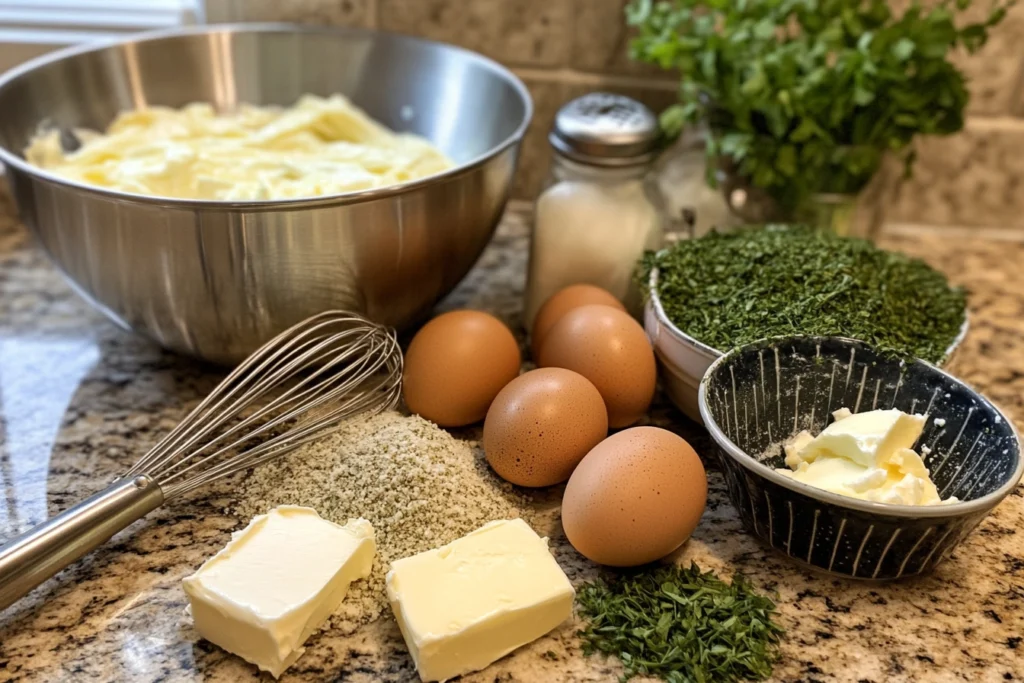Discover the Secret Ingredient That Transforms Your Omelet
An omelet, seemingly simple, holds a world of complexity within its folds. From texture to flavor, every detail matters. But what’s the secret ingredient that takes an omelet from good to unforgettable? In this article, we’ll uncover the mystery, explore culinary tips, and reveal professional secrets to help you create the ultimate omelet. Let’s crack this mystery wide open, starting with the basics.
Introduction and Basics of an Omelet
A Quick History of the Omelet
The omelet, or “omelette,” has graced tables across the world for centuries. Its roots can be traced back to Persia, where early versions of the dish were cooked with eggs and herbs. Today, cultural twists like the Crab Omelet showcase the omelet’s global versatility.
The Basics of a Great Omelet
A great omelet begins with just three simple components: eggs, butter, and salt. Yet, the magic lies in how you combine them. Properly beating your eggs introduces air, creating a fluffier texture. Using real butter ensures a creamy richness, similar to the silky finish of this Cream Cheese Stuffed French Toast Recipe.
Pro Tip: Always use fresh eggs at room temperature for the best results. This small change makes a big difference in both flavor and texture.
Exploring the Secret Ingredient

Why a Secret Ingredient Matters
What sets a remarkable omelet apart from a mediocre one? It’s not just skill but also the inclusion of a secret ingredient. Some may find inspiration in the unique twists used in recipes like the Avocado and Roast Chicken Omelet.
Top Secret Ingredients Used by Chefs
Professional chefs often turn to creative yet simple ingredients to transform their omelets. Let’s dive into some of these culinary tricks:
Dairy Enhancements: Cream, Milk, or Yogurt
Incorporating dairy, like heavy cream or yogurt, is a game-changer. These ingredients add a luscious creaminess and improve the fluffiness of your omelet. Milk, while common, can sometimes make the mixture too watery, so balance is key.
Did You Know? Greek yogurt not only enhances texture but also boosts protein content, making your omelet more nutritious.
Herbs and Spices: Chives, Parsley, or Turmeric
Herbs like chives and parsley give your omelet a fresh, aromatic lift. For an extra layer of intrigue, consider spices such as turmeric or smoked paprika. These additions can create vibrant flavors and even improve the dish’s visual appeal.
Unique Additions: Mayonnaise, Cornstarch, or Baking Powder
Some chefs swear by unconventional ingredients like mayonnaise for its richness or cornstarch for added structure. Baking powder, a surprising option, creates a cloud-like fluffiness that’s unmatched.
Pro Tip: For best results, whisk these ingredients into your eggs thoroughly to ensure even distribution and maximum effect.
How to Choose the Right Secret Ingredient
With so many options, how do you pick the perfect addition? Consider these factors:
- Flavor Profile: Do you prefer savory, tangy, or earthy tones?
- Dietary Needs: Are you aiming for low-fat or protein-rich options?
- Experimentation: Start small. Add just a teaspoon or pinch of an ingredient to gauge its impact.
The secret ingredient you choose will depend on personal taste, but the key is to stay curious and adventurous in your approach!
Techniques to Enhance Your Omelet
Mastering the Art of Egg Preparation
The foundation of a perfect omelet begins before you even turn on the stove. Proper egg preparation is essential to achieve the right texture and flavor. Let’s break it down step by step.
Beating the Eggs: How Much is Too Much?
Properly whisking your eggs is key. For an even more luxurious texture, consider techniques akin to preparing the batter for Banana Protein Pancakes.
Pro Tip: For the fluffiest omelet, add a splash of room-temperature water or cream to your eggs before beating them.
Temperature Considerations: Room Temperature vs. Cold Eggs
Room-temperature eggs mix better and cook more evenly, reducing the risk of overcooking. This attention to detail is similar to crafting the perfect Tortilla Quiche Bake, where every step counts.
Cooking Techniques to Elevate Your Omelet
Knowing how to cook your omelet properly is just as important as selecting the ingredients. The right techniques can make or break your dish.
Choosing the Right Pan
A non-stick pan is ideal for omelet-making because it ensures easy flipping and prevents sticking. Opt for an 8- to 10-inch skillet, which is the perfect size for most omelets.
Did You Know? A well-seasoned cast-iron pan can also work wonders, adding subtle flavor to your omelet over time.
Controlling Heat Levels
Cooking an omelet requires patience and precision. Use medium to low heat to prevent browning or burning the eggs. The goal is to cook them gently until just set.
Pro Tip: Heat your pan first, then add butter and let it melt completely before pouring in the eggs. This prevents sticking and creates a glossy finish.
Common Mistakes to Avoid
Even seasoned cooks can fall into these traps. Here’s what to watch out for:
- Overcooking: Remove the omelet from heat when it’s slightly undercooked, as residual heat will finish the job.
- Overloading Fillings: Too many fillings can tear the omelet or make it unevenly cooked.
- Skipping Preheating: A cold pan leads to uneven cooking and sticking.
Recipe Inspirations and Variations
Classic Omelet Recipes with a Twist
An omelet’s simplicity allows for endless possibilities. With just a few tweaks, you can turn classic recipes into gourmet delights. Let’s explore some variations that cater to different tastes and occasions.
French-Style Omelet
Master the art of the French-style omelet, just as you would refine a delicate Salmon Caesar Salad—simple yet elegant.
- Key Tips: Use a non-stick pan and stir the eggs constantly while cooking over low heat. Skip browning for a silky texture.
- Twist: Add a touch of fresh tarragon or crème fraîche to elevate the flavor.
Spanish Tortilla
Unlike the traditional omelet, the Spanish tortilla is hearty and filling.
- Key Ingredients: Eggs, thinly sliced potatoes, and onions cooked in olive oil.
- Twist: Add smoked paprika or manchego cheese for an authentic Spanish flair.
Asian-Inspired Omelets
These omelets are bold and flavorful, often incorporating unique spices and sauces.
- Key Ingredients: Soy sauce, sesame oil, scallions, and ginger.
- Twist: Add a dash of sriracha or hoisin sauce for an extra kick.
Gourmet Additions for a Modern Omelet
Take your omelet to the next level with these high-end additions:
Truffle Oil and Exotic Cheeses
A drizzle of truffle oil and a sprinkle of gruyère or gouda can transform a simple omelet into a luxurious meal.
Pro Tip: Use these sparingly to avoid overpowering the dish.
Plant-Based Alternatives
For a vegan-friendly option, swap eggs with chickpea flour or silken tofu.
- Enhancements: Kala namak (black salt) provides an egg-like flavor, while nutritional yeast adds a cheesy note.
Pairing Your Omelet with Sides
An omelet can be a complete meal, but pairing it with complementary sides enhances the experience.
- Light Options: Pair your omelet with a crisp side salad or even a slice of Avocado Toast with Egg and Apples for a balanced breakfast.
- Hearty Choices: For a heartier meal, serve your omelet alongside Chicken Tenders and Fries or roasted potatoes.
Did You Know? Omelets pair wonderfully with herbal teas or freshly squeezed orange juice for a balanced breakfast.
FAQs and Additional Insights
Frequently Asked Questions
What makes an omelet fluffy?
The fluffiness of an omelet depends on the air incorporated into the eggs during whisking and the cooking method. Adding a splash of cream or water can enhance its light texture. Cooking over low heat also prevents overcooking, preserving that soft, airy consistency.
Can I make an omelet without eggs?
Yes, plant-based alternatives like chickpea flour or silken tofu can be used to create vegan omelets. Black salt (kala namak) replicates the egg-like flavor, while nutritional yeast adds richness.
What’s the best pan for cooking omelets?
Non-stick pans are highly recommended for their ease of use and consistent results. An 8- to 10-inch skillet works well for most omelets. A well-seasoned cast-iron skillet is another great option for those who prefer added flavor.
How do I fix an overcooked omelet?
While you can’t reverse overcooking, try topping it with a creamy sauce or cheese to restore some moisture. In the future, remove the omelet from heat when it’s slightly undercooked to allow carryover cooking.
Are omelets healthy?
Omelets can be highly nutritious when made with wholesome ingredients. Eggs are rich in protein, and you can boost the dish’s health benefits by incorporating vegetables, herbs, or plant-based alternatives.
Nutritional Benefits of Adding a Secret Ingredient
Incorporating a secret ingredient can enhance not only the flavor but also the nutritional value of your omelet. For example:
- Greek Yogurt: Adds calcium and protein while keeping the dish light.
- Herbs: Provide antioxidants and vitamins.
- Spices like Turmeric: Known for anti-inflammatory properties and a boost to immunity.
Did You Know? Even unconventional ingredients like avocado can increase the omelet’s healthy fat content, keeping you full for longer.
Conclusion and Final Thoughts
Wrapping Up the Mystery of the Secret Ingredient
At its core, the secret ingredient in an omelet isn’t just about the physical addition—it’s about creativity, experimentation, and passion for cooking. From using dairy to enhance fluffiness to incorporating bold herbs and spices for a flavor punch, the possibilities are endless.
Remember, the perfect omelet is a combination of technique, quality ingredients, and a willingness to explore. Whether you’re mastering the French-style omelet, crafting a hearty Spanish tortilla, or adding a gourmet touch, your secret ingredient should align with your taste and vision.
Pro Tip: Don’t be afraid to try new combinations. Who knows? You might discover your own signature ingredient that becomes a family favorite!
Now that you know the secrets to crafting the ultimate omelet, it’s time to put these tips into practice. Share your creations, experiment with unique ingredients, and inspire others to elevate their breakfast game.
Explore related recipes like the Scrambled Eggs with Cottage Cheese for more inspiration.
Happy cooking!

